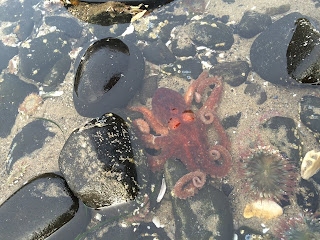
It’s that time again! The full moon is approaching, bringing some of the lowest tides of the year and the tide pools are waiting for explorers! Exposure at the Needle during a negative low tide Photo Courtesy of Alanna Kieffer Tides for the approaching week: Friday, July 31 st – low tide: -1.4’ @ 7:18 AM High tide: 6.7’ @ 1:56 PM Low tide: 1.6’ @ 7:20 PM Saturday, August 1 st – low tide: -1.5’ @8:00 AM High tide: 7.1’ @ 2:36 PM Low tide: 1.2’ @ 8:10 PM Sunday, August 2 nd – low tide: -1.4’ @ 8:41 AM High tide: 7.3’ @ 3:16 PM Low tide: 0.8’ @ 8:59 PM Monday, August 3 rd – low tide: -1.1’ @ 9:22 AM high tide: 7.5’ @ 3:57 PM Low tide: 0.6’ @ 9:50 PM Tuesday, August 4 th – low

